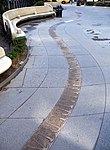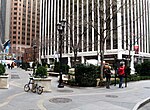1 William Street

1 William Street is an office building in the Financial District of Lower Manhattan in New York City. The building has had a number of names, originally the J. & W. Seligman & Company Building, and later the Lehman Brothers Building. Currently it is also known as the Banca Commerciale Italiana Building. The building, erected in 1906–1907, was designed by Francis H. Kimball in conjunction with Julian Clarence Levi. It was created for the Seligmans, a prominent German Jewish family who founded an investment bank called J. & W. Seligman. The building was later the headquarters of investment bank Lehman Brothers from 1929 to 1980, and was subsequently bought by Banca Commerciale Italiana. The 11-story structure, clad in limestone with a steel frame, is located at the southern corner of the five-pointed intersection of William, South William, and Beaver Streets. It occupies a quadrilateral lot, with an acute angle between South William Street to the west and William Street to the east. In 1996, the building was designated as a landmark by the New York City Landmarks Preservation Commission. In 2007, the building was designated as a contributing property to the Wall Street Historic District, a National Register of Historic Places district.
Excerpt from the Wikipedia article 1 William Street (License: CC BY-SA 3.0, Authors, Images).1 William Street
William Street, New York Manhattan
Geographical coordinates (GPS) Address External links Nearby Places Show on map
Geographical coordinates (GPS)
| Latitude | Longitude |
|---|---|
| N 40.7048 ° | E -74.01 ° |
Address
1 William Street
William Street 1
10038 New York, Manhattan
New York, United States
Open on Google Maps









